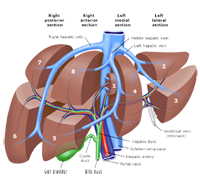Resection

Criteria for liver resection surgery.
We each have eight (8) liver segments. At least two (2) of these liver segments must be relatively cyst free and remain intact following liver resection surgery. Doctors can remove up to six (6) segments from a polycystic liver or up to ¾ of the liver. The gallbladder is simultaneously removed. Once surgery has been completed, there are three (3) vessels that supply the liver with blood. One of these blood vessels must remain undamaged to nourish the liver remnant. The surgeon will use CT or MRI images to determine if we are a eligible for a liver resection or if we might be better served by a liver transplant or TAE procedure or medical treatment with the not yet released octreotide or perhaps we might be included among the lucky 92% that require no treatment whatsoever.
D M Nagorney MD was the first surgeon who ever conceived of the idea of performing a liver resection to help individuals with severe polycystic liver disease. Dr. Nagorney has specialized further by performing mainly liver resection surgery; he is a liver resection surgeon. Many years ago, Dr. Torres approached his colleague, asking him if any relief might be provided to patients with severe PLD Polycystic Liver Disease. Dr. Nagorney, Dr. Torres, and Dr. King have published a paper on the long term follow up of the Mayo Clinic Experience with Liver Resections for PLD Polycystic Liver Disease. This surgery is long, taking 8 hours or more. A cystic liver can weigh up to 40 pounds. Following surgery be prepared for possible weight loss and loss of body fat with some muscle wasting. Recovery can take anywhere from two weeks to a year, depending on your own personal situation. For many who have liver resection surgery performed by Dr. Nagorney the relief has been permanent. All say they would do it again.
Some have experienced liver cyst re-growth following a liver resection. For this there are doctors who recommend taking octreotide analogues following a liver resection. Some have experienced HVOO following a liver resection. Others have experienced Pudendal Nerve Entrapment, PNE. Almost all have had generalized candida or an overgrowth of yeast in the intestinal bacterial flora. HVOO may require some creative surgery or exercise to coax the body to grow new vessels around the stricture. PNE requires the help of a knowledgeable urologist. Yeast can be treated with a number of medications. Many try increasing alkalinity with an alkaline diet. Garlic is very helpful for returning the intestinal flora to a balance. Others have tried acidophilus tablets. There are many prebiotic vegetables listed here.
Hepatic regeneration recovery following liver resection
Essential fatty acids improves liver resection recovery in animal studies. Omega-3 FAs effectively reduced severe hepatic steatosis, which was associated with improved liver regeneration and functional recovery following partial hepatectomy. Some useful vegan essential fatty acids can be obtained from hempseed oil capsules, purslane, and chia seeds.
Helpful Links
Segments of the Liver
Liver Anatomy
Mayo Liver Resection
Synopsis Mayo Liver Resection Article
Avoid Before Surgery
Try After Surgery
Octreotide Study
Octreotide
Octreotide Side Effects